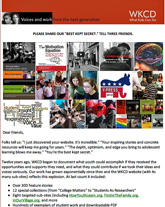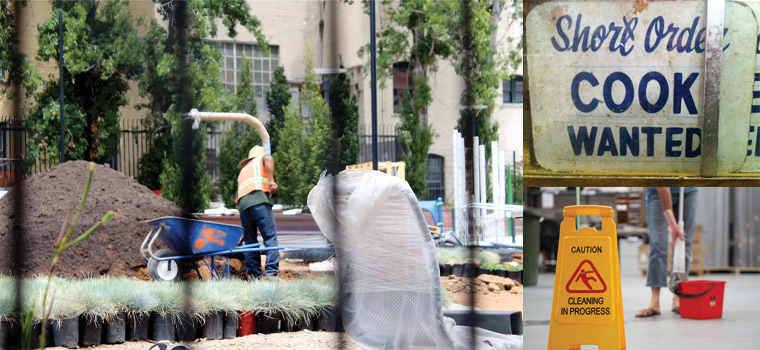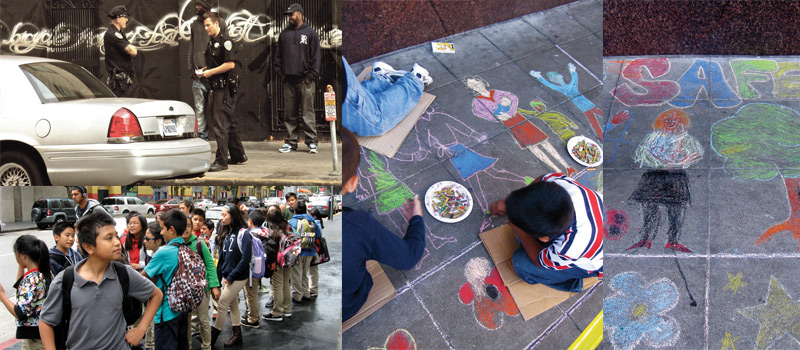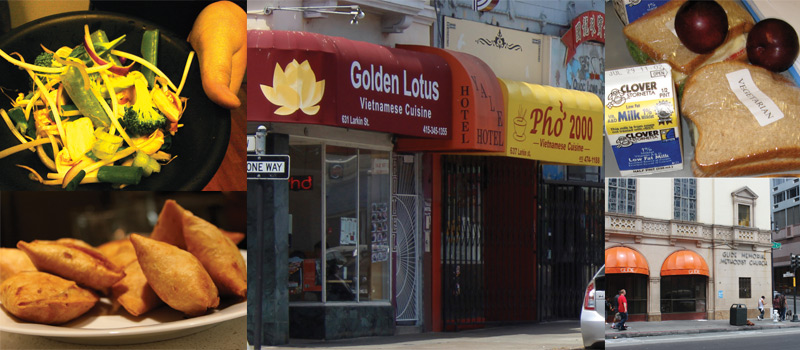SUBSCRIBE TO OUR____ NEWS BLAST
OTHER WKCD WEBSITES SPECIAL COLLECTIONS Students as Allies in School POPULAR WKCD PUBLICATIONS (PDFS] A Guide to Creating Teen- Cultural Conversations through Creative Writing Documenting Immigration Stories First Ask, Then Listen: How Your Students Can Help You Teach Them Better Making Writing Essential to Profiles of Politically Active Youth Queer Youth Advice for Educators The Schools We Need: Creating Small High Schools That Work for Us
| San Francisco's Tenderloin Through the Eyes of Its Youth by Barbara Cervone and youth at Boys & Girls Clubs of San Francsico, Tenderloin Clubhouse | DECEMBER 15, 2014
For the past several months, WKCD has been working with youth at Boys & Girls Clubs of San Francisco's Tenderloin Clubhouse to create a photo essay book about their "village," just blocks from the city's wealthy financial district. Known for its large population of homeless and drug dealers and its long history of ill-repute, the Tenderloin has also become a bustling home to immigrant families drawn to its low rents. Since 2011, the Tenderloin Clubhouse has offered an award-winning photo voice program to its youth. Our book will present the images, voices, and perspectives from these young photo journalists, growing up in what most regard as San Francisco's most troubled neighborhood. It's a story you won't want to miss. Here we share three additional chapters: on hard work and sacrifice, danger and safety, and food. Youth at the Tenderloin Clubhouse took virtually all of the photos that appear in the book.
Hard work and sacrifice SHORT-ORDER COOK, CHAMBERMAID, ten-hour days, minimum wage. In a neighborhood where unemployment spills onto the sidewalks, hard work is a subject kids at the Tenderloin Club know by heart. They have learned it from their parents, for whom labor and sacrifice is a reflex, like breathing.
Hard work has become a reflex for Tenderloin Club youth, too.
For older kids at the Clubhouse, caring for younger siblings is their first job. “You are responsible for taking care of your brothers and sisters,” says Dayana who has two younger brothers. “It’s a big responsibility. Your parents expect that. My mom always tells me, ‘You have to be the leader.’” There is an unspoken agreement that teens with paying jobs will contribute to the family budget. “I started working ever since I was a sophomore,” Naim explains. “When I got my first job, my dad said I needed to start paying for my own lunch and my clothes and stuff. I needed to take a load off my dad.” He describes his work life:
Danger and safety “DON’T YOU WORRY ABOUT GETTING KILLED?” people sometimes ask young people at the Clubhouse. The Tenderloin has the highest rate of violent crime of any district in San Francisco. But youth who live in the Tenderloin learn to size up danger, they explain. “The homeless man staring up from the sidewalk may look scary, but he means no harm,” says a middle-school-age girl sitting outside the art room. “The people lined up outside the soup kitchen, they may cause you to look away, but they aren’t dangerous.” “The people who dress weird, they’re into show,” her friend adds. “The ones that steal for drugs, now that’s danger. But it’s not us they’re after.” In 2012, adults in the Tenderloin started “Safe Passages,” a program to protect kids on their way to and from afterschool programs. On the walk up Jones Street from the Clubhouse, a sidewalk trail of yellow footprints and drawings of children holding hands stretches ten blocks. Every afternoon, the Club’s teen and adult staff members follow the footprints, escorting kids in groups from nearby schools to the Clubhouse. At the end of the day, staff members walk those children home who live along the path. “You see the mural of boys and girls and trees and stars and hearts and lots of color?” points out Maria. “We drew that with chalk with our art teacher. It shows a safe world.” Seventeen-year-old Eslah, who has lived in the Tenderloin since she was two, has her own views on safety. “Living in the Tenderloin, I don’t really notice that much crime,” she says, “even though you hear the sirens everywhere.” My cousin’s friends that come from Oakland, they be like, “Oh, how can you live in the Tenderloin?” I’m like, “Yeah, it’s scary, but the people are nice.” That’s the thing. You walk and mind your own business and they mind theirs. Actually, they respect you. Some give me Salaam, they say “hi,” you know, in Islamic. And I’m just like, “Oh, hi!” It feels good. Dayana, age nine, makes another point.
Talking about food WHICH TASTES BETTER, pupusas or samosas, pho or falafel? What’s the difference between northern and southern Vietnamese food? Who likes mac and cheese, popcorn, bacon? Who enjoys school lunch? In the Tenderloin, food is a complicated subject. For the kids at the Club, there’s what you eat at home, what you find in the small restaurants all around the neighborhood, American food, federal breakfast and lunch, donated food, snacks, and more. They start by describing what they eat at home. “My mom is from the Philippines and she likes to cook adobo.” “My family is from Mexico and we eat carne asada.” “My mom and dad suffered under the Khmer Rouge in Cambodia and everything my mom makes involves rice.” “My parents are from Korea. My dad does the cooking and he likes to prepare kimchi.” Albert’s mother is a vegetarian and the food his father makes doesn’t appeal to him. So he prepares his own meals. “Last night I made codfish and rice.” When Eslah talks about her mother’s cooking—and her own contributions—the words tumble out.
ON THE STREETS HERE, RESTAURANTS AND SANDWICH SHOPS serve up specialties like these and much more. The Tenderloin has become known for good and inexpensive ethnic food. The bahn mi at Saigon Sandwiches, at $3.25 each, draw long lines every day. Down the street, Burmese Kitchen serves fermented tealeaf salad with cabbage. Someone told Evelynn that the paneer in an Indian restaurant near here was “the best they had ever tasted,” she said. Christian, who is from Honduras, reports that “there’s Latin American food on every corner,” although he admits that in the nearby Mission District “it’s much, much better.” In fact, few of these Clubhouse youth eat at restaurants that win stars from critics. They say they would rather get treated to a meal at Kentucky Fried Chicken or a smoothie at Emo’s Café and Deli. “THE FOOD I DON’T CARE FOR,” notes Marco, “is the lunch we get at school—you know, the government lunch. It has no taste and it’s hard to swallow.” All the Clubhouse youth qualify for that free or reduced-price lunch. And some of their parents frequent one of the food pantries spread across the Tenderloin. “That’s how I learned about peanut butter,” one nine-year-old says. At the corner of Taylor and Ellis Streets, the line at Glide Memorial Church stretches around the block, a familiar streetscape for the Clubhouse youth. Glide houses one of the city’s oldest and best-known soup kitchens, feeding several thousand people a day. Today’s lunch includes a tuna sandwich, stewed carrots, macaroni and cheese, a ripe apple, and a small cup of organic strawberry ice cream.
What Kids Can Do, Inc. | info@whatkidscando.org | www.whatkidscando.org
|





